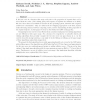Free Online Productivity Tools
i2Speak
i2Symbol
i2OCR
iTex2Img
iWeb2Print
iWeb2Shot
i2Type
iPdf2Split
iPdf2Merge
i2Bopomofo
i2Arabic
i2Style
i2Image
i2PDF
iLatex2Rtf
Sci2ools
APPROX
2015
Springer
2015
Springer
Approximating Hit Rate Curves using Streaming Algorithms
A hit rate curve is a function that maps cache size to the proportion of requests that can be served from the cache. (The caching policy and sequence of requests are assumed to be fixed.) Hit rate curves have been studied for decades in the operating system, database and computer architecture communities. They are useful tools for designing appropriate cache sizes, dynamically allocating memory between competing caches, and for summarizing locality properties of the request sequence. In this paper we focus on the widely-used LRU caching policy. Computing hit rate curves is very efficient from a runtime standpoint, but existing algorithms are not efficient in their space usage. For a stream of m requests for n cacheable objects, all existing algorithms that provably compute the hit rate curve use space linear in n. In the context of modern storage systems, n can easily be in the billions or trillions, so the space usage of these algorithms makes them impractical. We present the first...
Related Content
| Added | 16 Apr 2016 |
| Updated | 16 Apr 2016 |
| Type | Journal |
| Year | 2015 |
| Where | APPROX |
| Authors | Zachary Drudi, Nicholas J. A. Harvey, Stephen Ingram, Andrew Warfield, Jake Wires |
Comments (0)

